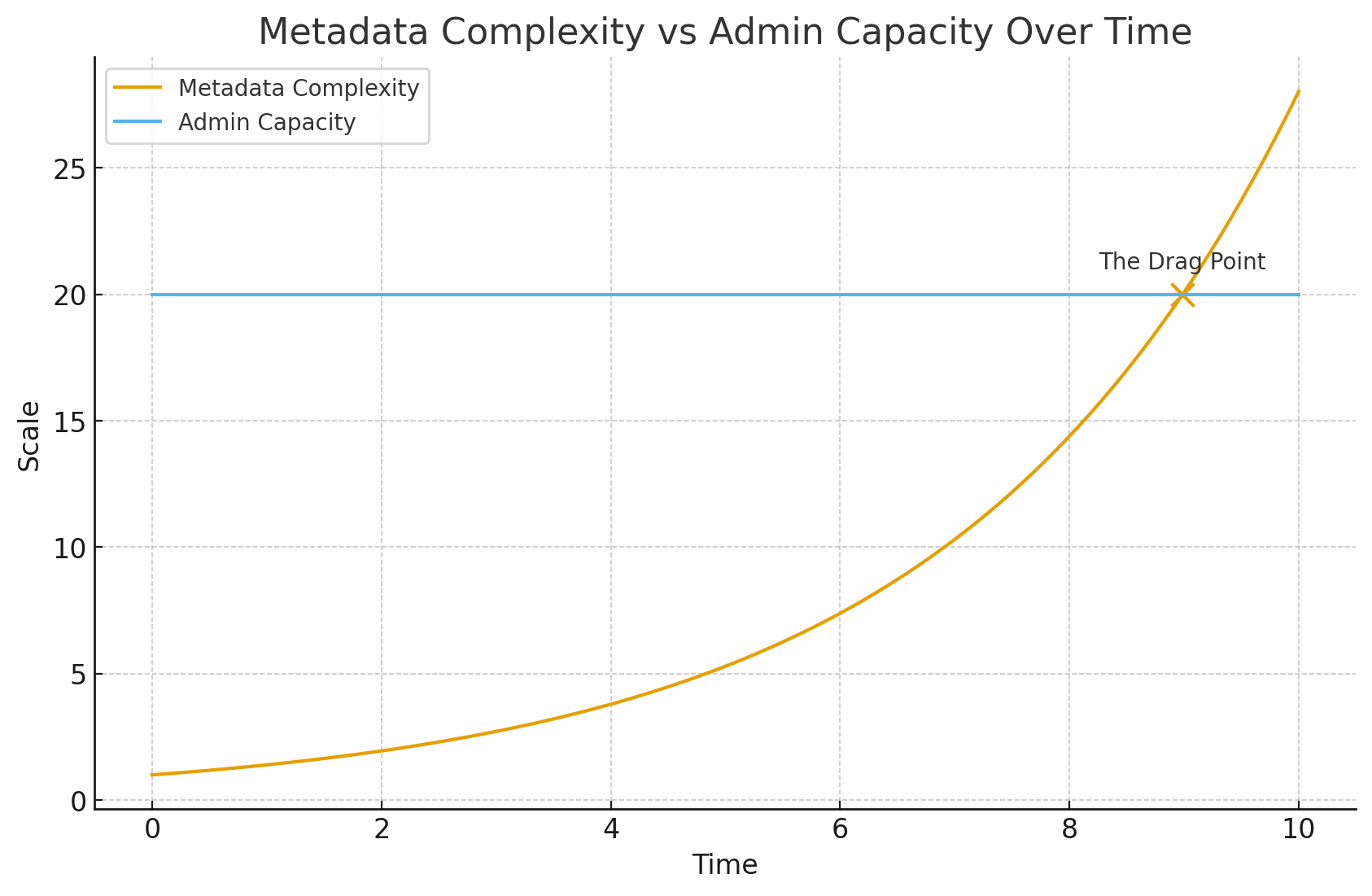There’s a moment every Salesforce org eventually reaches as it grows — a moment when the benefits of growth start to reduce, when growth itself turns to friction, when adding one more automation suddenly slows everything down instead of speeding it up.

We call this moment The Drag Point.
The orange line on the graph above represents metadata complexity — the total, exponential compounding multiplication of every Flow, validation rule, Apex trigger, formula field, and “quick fix” that’s been layered into your org over the ages.
You can see, obviously, that the curve isn’t linear. Rather, it’s exponential. This is a reflection of how complexity compounds in real systems. Every new piece of metadata doesn’t simply add one more unit of complexity. It creates new relationships with everything that already exists. Each dependency, each condition, each reference expands the surface area of potential conflict.
Add one object, and you create a dozen new fields.
Add a field, and you create a dozen new validation paths.
Add a Flow, and suddenly you have a dozen other automations that can trigger it, block it, or override it.
This is why Salesforce orgs don’t fail gradually, they fail suddenly. Complexity accumulates invisibly, until one day a simple change request (a picklist, a new process, a checkbox) sets off a cascade of unintended consequences.
By that point, you’re not managing a CRM anymore. You’re managing an ecosystem — one that’s dynamic, interconnected, and at times wildly unpredictable. Like any ecosystem, it doesn’t grow linearly. It compounds.
That’s why the orange line climbs the way it does. Because every “small fix” becomes a multiplier.
And it’s also why the blue line — admin capacity — stays stubbornly flat. Human comprehension and ability doesn’t scale at the same rate. You can’t double your mental model of a system just because it doubled in size. (Not until we become cyborgs, at least.)
Where those two lines meet, that’s The Drag Point — the moment where exponential complexity collides with linear capacity, and the system’s growth curve begins to carry tremendous risk.
The Drag Point has always existed, Agentforce just exacerbates the issue
Here’s the part people are missing about Agentforce: it isn’t magic. It’s metadata.
It’s a new class of metadata capable of making decisions — non-deterministic, sometimes opaque ones — inside an already complex system. And it can be added by the same users who’ve been building Flows, validation rules, and custom fields for years.
The danger here is that the representative slope above just got steeper.
Salesforce’s greatest strength, infinite customization, has always been a double-edged sword. Each new capability adds power, but also risk. Flows trigger other Flows. Validation rules contradict Process Builder logic. Fields linger long after their owners have moved on.
Now imagine adding autonomous agents that can act within that same tangled web.
Welcome to the same problem, amplified.
AI governance without understanding is a new breed of paralysis
Every company is talking about “AI governance.” But you can’t govern what you can’t see.
And most teams still can’t see their metadata clearly. They don’t know where automations overlap, which fields are obsolete, or how one small change can create ripples through the system. The result is either lockdown that stifles innovation, or chaos that accelerates decay.
Both are symptoms of the same thing — hitting The Drag Point without realizing it.
Escaping Salesforce's Drag Point
There’s only one way out of this impending mess: metadata intelligence.
Before layering AI on top of your org, you need to understand the foundation it’s built on.
You need to know what automations already exist and where they conflict.
You need to see which fields are used, which are dead weight, and which dependencies will break if an agent touches it.
That’s precisely what Sweep was built for.
Sweep gives you the visibility to understand your metadata at-scale, mapping relationships, spotting conflicts, surfacing risk, and especially important now… documenting change. It’s how teams reverse entropy, rebuild trust in their systems, and keep their orgs operating below The Drag Point.
Because the future of Salesforce isn’t about avoiding agents. It’s about preparing your metadata to handle them.
Agentforce isn’t the villain. Unmanaged metadata complexity is.
The orgs that win in the age of AI will be the ones that understand their systems deeply — not the ones that bolt on governance policies after the fact.
At Sweep, we help you fix the foundation before you reach The Drag Point — giving your teams the clarity, control, and confidence to move faster without breaking things.

